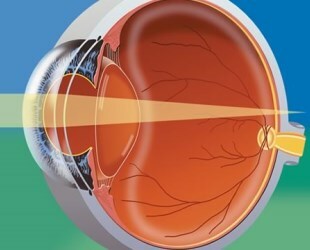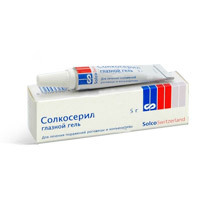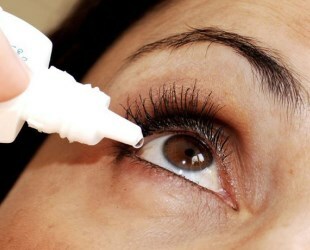
About a quarter of the world's population is facing a problem that everyone knows as farsightedness.
Another name is more scientific - hypermetropia. This is a visual impairment, in which the image is focused behind the retina, not on it.
To get a clear image, you need to strengthen the refraction, and for this you need to strain your eyes.
That's why most people with hyperopia quickly get tired and experience headaches when working at a computer or with documents.
There is a misconception that long-sighted people can see well into the distance and see badly near. In fact, they can see bad things.
- 1. About refractive error
- 2. Symptoms and Diagnosis
- 3. Causes of
- 4. Treatment of
- 5. Prevention of
- 6. Conclusion
About refraction violation
History of
The term appeared in 1864.He was introduced by Franz Donders, a physician and physiologist from Holland. This specialist is one of the founders of ophthalmology. Donders described hypermetropia and other defects in his book of 1864, where he also introduced the concepts of ametropia, emmetropia, described the basics of optical correction of eye disorders, explained the connection between refraction and accommodation, and began using lenses.
Hyperopia is a type of clinical eye refraction in which the focus of parallel rays after refraction lies behind the retina. While Bates studied natural methods( with the help of exercises), Donders and other scientists introduced optical methods to improve the functions of the eyes.
Today there are no powerful preventive drugs that protect against farsightedness. Therefore it is important to check regularly with the oculist and monitor your health. It is also important to remember that hypermetropia appears for various reasons. The source of most of them are somatic disorders and psychological problems.
Plus or minus?
A frequent question in the discussion of the concepts of hyperopia and myopia is the division of them into "plus" and "minus".In general, these values are necessary for the selection of glasses and the idea of visual acuity.
The power of glasses for glasses is measured in diopters. For people with farsightedness glasses with collecting glasses are required, which will take on a certain function of the lens of the eye. Such glasses are called positive and are denoted by the plus sign( +).
There are three types of hypermetropia in terms of the degree of impairment:
- weak( up to + 2.0 D),
- average( up to + 5.0 D),
- high( over + 5.0 D).
Symptoms and Diagnosis

The main symptoms or manifestations of hyperopia are:
- poor vision near,
- rapid eye fatigue when reading and working on the computer,
- burning eyes, headaches.
Diagnosis of hypermetropia occurs by checking visual acuity according to the Sivtsev table. Also, the diagnosis of farsightedness involves the use of a foropter and the use of the method of autorefractometry.
The methods of keratometry and echobiometry are used to measure the optical power of the cornea and the length of the longitudinal axis of the eye. In young children, the diagnosis is carried out only after the pupils are forcedly dilated, which weakens the accommodation of the eye.
Risk Factors
When there is a progressive, then without correction, it can cause amblyopia, cause complete loss of vision or strabismus.
If the child has a weak hypermetropia from +3.0 and "plus" increases, then there is a chance of earning a strabismus due to muscle overstrain.
Farsightedness is most often affected by the following categories of people:
- often occurs in children and youth, with a mild form of the disease rarely manifested;
- senile develops in people who work hard for a PC, read, sew, strongly strain the eye muscles throughout life;
- development of senile farsightedness is a natural process for all people after 40 years. But the progress of the disease slows down through exercise.
Prevalence of
- Hypermetropia is common among children and adults. It occurs in 9 out of 10 babies, but does not require treatment and passes with age.4 out of 10 adults have this disease.
- About 25% of all people have this anomaly.
- Almost all infants developed hyperopia. With age, this defect disappears, because the eyeball grows.
- The senility arises from the fact that the lens ceases to change its curvature. The process begins after 25, and by 40-45 years, vision deteriorates and read at a distance of 25-30 cm is no longer obtained. By 60-70 years the accommodation is weakening.
- In children, the disease can be congenital. Vision does not normalize even after a while.
Causes of
It is believed that age to the year and older than 50 years is always accompanied by hyperopia.
One of the reasons that explains its appearance in all newborns is a smaller eyeball on the anteroposterior axis. Therefore, for them, hyperopia is a completely natural state of the visual analyzer.
However, there are cases when this disease is congenital and does not pass with the growth of the baby. Here the reason is the inherent weakness of the ability of the lens or cornea to refract light. In this case, such children may be aggravated with age due to the problem with vision: due to the constant tension of the oculomotor muscles and eye-to-nose with the goal of making the image more clear, strabismus can develop. Later this can lead to amblyopia - a weakened vision for one eye.

For people over 50, the appearance of hyperopia is also a natural process.
The tissues and muscles of the eye change, the lens becomes denser, the ability of the eye to refract rays decreases.
It is impossible to prevent all these processes, but you can avoid the negative consequences of age-related farsightedness: headache, overexertion, decreased vision.
For this purpose it is necessary to use the appropriate methods of treatment that are determined by the ophthalmologist.
Treatment of
The goal of treatment in the case of hyperopia is to change the ability of the eye to focus the image on the retina, not behind it. The most common and effective methods are wearing glasses, performing some exercises, and also operations.
Conservative treatment of
People with farsightedness wear glasses during reading, working at a computer, watching TV or other activities that require a close look at the view. In addition to glasses, you can wear contact lenses. They are comfortable during sports and other activities that require physical activity.
Also, conservative methods of treatment include wearing special glasses-simulators, ultrasound therapy, vacuum massage, electrostimulation, taking vitamins, which can significantly improve vision without resorting to surgery.
Surgical intervention
Laser methods will give the cornea the desired curvature, the image can get on the retina. In some cases, it is necessary to use a lensectomy( lens removal), a replacement for a special intraocular lens, photorefractive keratectomy, thermokeratoplasty, thermokeratocoagulation.
The laser will relieve hypermetropia with astigmatism. After the operation, the shape of the cornea changes, refraction. As a result, you can correct vision at +6 diopters. Before the laser ophthalmologist examines the eyes, assesses the degree of farsightedness and decides whether to carry out this procedure.
It is important to identify contraindications for the operation. The whole process of laser treatment takes 30 minutes and is painless, gives very accurate results.
There are several laser methods: LASIK, Femto LASIK, SUPER LASIK.These are the fastest methods of correction of hyperopia. Everything is done under local anesthesia. After the operation, you can go home the same day. Surgery enhances the refraction of abilities.
Thermokeratoplasty - application of coagulates by a metal needle on the cornea, which eventually contracts, strengthening the refraction of the central optical zone. Laser coagulation from keratoplasty is distinguished by the use of laser radiation.
The laser technique costs from 17 thousand rubles .Other options cost 25 thousand ( LASIK) or 50-60 thousand rubles ( Femto, SUPER).The prices for all operations are indicated for one eye.

Read further - eye Solcoseryl gel. Description of the preparation.
In the article( in more detail) the nature of people with chameleon eyes.
Prophylaxis of Blepharitis!http: //moezrenie.com/bolezni/ zabolevaniya-vek / blefarit-glaz.html
If all of the listed methods are ineffective, they can implant the eye with a multifocal lens. With the help of this method, diseases of the highest degree are treated.
Medical preparations

If we talk about drops and other drugs, then a special drug for the treatment of hyperopia has not yet been invented.
Drops are used only to eliminate some of the attendant symptoms:
- , if the farsightedness has unpleasant sensations in the eyes, it may be caused by an infection for which certain drops are applied, or the typical dry eye syndrome now, for which Vizin Clean Tear is used, "Artificial tear" or "Taufon",
- if age farsightedness is accompanied by cataracts, for its treatment doctors can also prescribe drops that slow its development and stimulateProcesses exchange,
- if hyperopia additionally accompanied by allergic reactions to some objects may be assigned "Claritin", "Prenatsid" or other drugs.
Drugs with vitamins are also often prescribed, but they should not be used continuously, but only by courses. In any case, you should adhere to the prescription of the doctor, and not engage in self-medication.
Exercises
Scientists have created special exercises that help restore visual acuity and completely get rid of hypermetropia. They also help to prevent its appearance, if a person is genetically predisposed to it.

Pay attention - the price of tetracycline ointment. Price overview in the CIS.
In the news( here) instruction on Riboflavin.
Analogues of eye drops Indocollir!http: //moezrenie.com/lechenie/ kapli-dlya-glaz / indokollir-bystraya-pomoshch-pri-bolyakh-glaz.html
The course of exercises should be performed every day. Each exercise is performed 5-10 times. Sitting in a comfortable relaxed pose, you have to look in front of you. First without sharp movements, you need to turn your head to the right, with it turning your gaze, slowly return to its original position, and then turn to the left. Sitting in a relaxed pose, you need to move your eyes from the distant to the near object: first 2-3 seconds to look into the distance, and then 3-5 seconds to look at located 25-20 cm from the face of the index finger or pencil.

Another set of exercises was developed by W. Bates, and it was based on the fact that the main problem of hypermetropia is eye strain in trying to examine the subject, and therefore the exercises are mainly aimed at relaxation:
- Daily for 10-15 minutes, you need to read a book with a small font, keeping it at a distance of 30 cm from the eyes, without using glasses, with good and dim lighting. Dull color helps relax the eyes. If you just can not read without glasses, you can first do the exercise in them.
- While reading the book you need to look at the white clean space between the letters and the lines.
- Even with senile hyperopia, the following exercise can help. You need to hang the Sivtsev table in a darkened place so that from a distance of about 5 m you can see the letters. With this exercise, the eyes will need to make some effort. In hand, you need to take a small format table Sivtseva, providing good lighting. First, you need to read a large table( as many lines as you can get), and then look at the small table and lead it between the lines along clean paper, remembering to blink.
- At the window or on the street you need to translate the view from distant objects( sky, wall, grass) to a table of manual format.
- It is useful to watch movies, watch flying birds, monitor any moving objects.
- Another useful exercise is the big turns with the concentration of the look in front of you. It is necessary to stand facing the window, it is desirable that it had lattices or other vertical alternating objects. You need to stand straight, your arms are relaxed. The body should be turned slowly to the left, to stand parallel to the left wall, then also smoothly turn it to the right. The view should always be directed in front of you, the head and shoulders move together. To check whether your eyes are relaxed, it is very easy: if close objects( bars on the window) slip from the view in the opposite direction, and the distant objects( outside the window) move in the same direction as the turn, then it was possible to achieverelaxation.
Prevention
The following are considered as measures to prevent farsightedness:
- correctly selected lighting( not too bright, not too dark),
- mobile way of life,
- regular walks in the open air,
- balanced nutrition( all necessary vitamins andmicroelements),
- limiting visual loadings( if possible, alternating them with physical exercises),
- visual gymnastics,
- the right choice of workplace, computer installationbut, comfortable for the eyes reading.
Conclusion
Hypermetropia can occur or appear at any age. To reduce the likelihood of developing this disease, you need to take care of your health( both physical and mental), protect the body from stress, train the eye muscles with exercises.
And every six months go to the oculist so that he can check your current state of health and visual acuity. So you save and even improve the quality of visual perception of the surrounding world, which will have a positive impact on the level of enjoyment of life and the brightness of the colors of the world that surrounds you.
